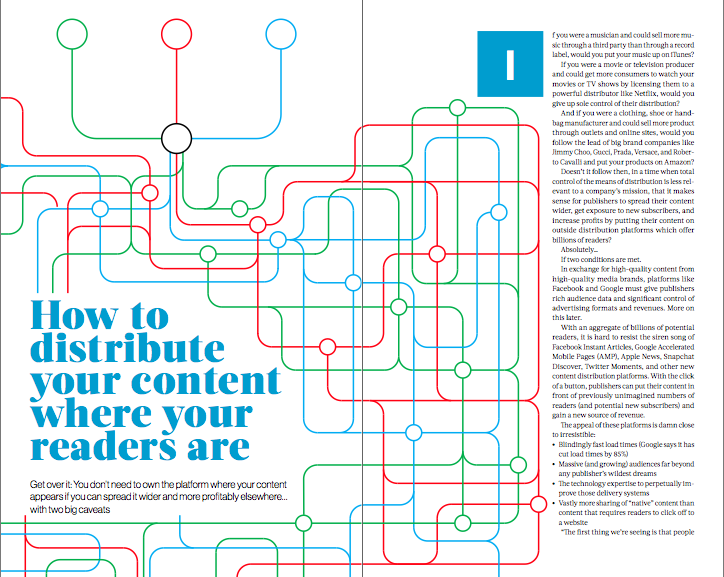
26 Oct How to distribute content where your readers are
Get over it: You don’t need to own the platform where your content appears if you can spread it wider and more profitably elsewhere… with two big caveats
If you were a musician and could sell more music through a third party than through a record label, would you put your music up on iTunes?
If you were a movie or television producer and could get more consumers to watch your movies or TV shows by licensing them to a powerful distributor like Netflix, would you give up sole control of their distribution?
And if you were a clothing, shoe or hand- bag manufacturer and could sell more product through outlets and online sites, would you follow the lead of big brand companies like Jimmy Choo, Gucci, Prada, Versace, and Roberto Cavalli and put your products on Amazon?
Doesn’t it follow then, in a time when total control of the means of distribution is less relevant to a company’s mission, that it makes sense for publishers to spread their content wider, get exposure to new subscribers, and increase profits by putting their content on outside distribution platforms which offer billions of readers?
Absolutely…
If two conditions are met.
In exchange for high-quality content from high-quality media brands, platforms like Facebook and Google must give publishers rich audience data and significant control of advertising formats and revenues. More on this later.
With an aggregate of billions of potential readers, it is hard to resist the siren song of Facebook Instant Articles, Google Accelerated Mobile Pages (AMP), Apple News, Snapchat Discover, Twitter Moments, and other new content distribution platforms. With the click of a button, publishers can put their content in front of previously unimagined numbers of readers (and potential new subscribers) and gain a new source of revenue.
The appeal of these platforms is damn close to irresistible:
- Blindingly fast load times (Google says it has cut load times by 85%)
- Massive (and growing) audiences far beyond any publisher’s wildest dreams
- The technology expertise to perpetually improve those delivery systems
- Vastly more sharing of “native” content than content that requires readers to click off to a website
The first thing we’re seeing is that people are more likely to share these articles, compared to articles on the mobile web, because Instant Articles load faster — the majority load in under a second — and that means people are getting to the content immediately,” Facebook Instant Articles product manager Michael Reckhow told The Neiman Lab, a journalism think tank at Harvard. “In terms of engagement, the Instant Articles outperformed the regular links by a significant factor. They were shared over 3.5 times more, liked over twice as much, and commented on almost five and a half times more than the regular links.”
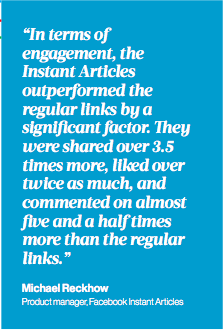
“As publishers see traffic to their home pages waning, publishing directly to platforms like Facebook becomes a priority,” Duncan McMonagle, chief revenue officer of UK-based football site 90min.com, told Digiday.
“Instant Articles is a significant move for- ward in terms of user experience and the speed with which articles will load,” he said. “Any time an experience or the product is faster and better, it means people will consume more articles and leave with a heightened sense of quality brand experience.”
That quality experience on Instant Articles, which is currently only available on iPhone and Android mobile devices, includes some very attractive interactive features, including allowing readers to expand text, explore pictures in high definition when moving the phone, tilt-to-pan photos, auto-play video, interactive maps, and embedded audio captions that let readers explore stories in beautiful new ways.
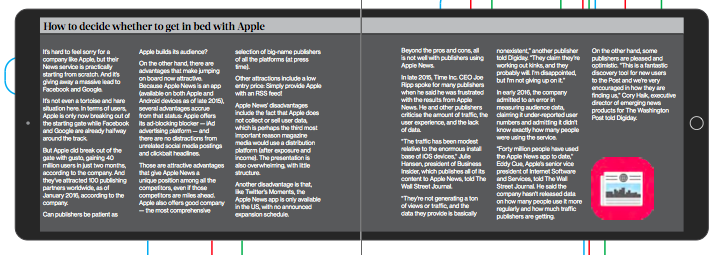
Facebook readers “have the opportunity to take advantage of… the ability to turn your phone and see all sides of a photo — it’s brilliant,” Cory Haik, Washington Post executive director of emerging news products, told the 2015 Paley International Council Summit. “So we’ve been producing to that, putting these panoramic photos on Facebook and watching users engage with that. That’s not something we can do currently on the mobile web. That’s new storytelling.”
In addition to increased speed and inter- activity, publishers can maintain their visual identity and also monitor audience data using their own tools and through Instant Articles partner comScore.
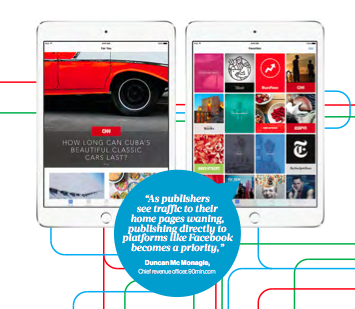
Instant Articles is also publisher-friendly in that it uses web languages and systems that most publishers already use: RSS and HTML. Facebook and most of the other platforms are also making efforts to answer publishers’ needs for advertising and branding flexibility.
For starters, the advertising revenue deal seems fair. At Apple and Facebook, for example, publishers get to keep 100% of what they sell. If Apple or Facebook sell spots, the publishers still get 70%.
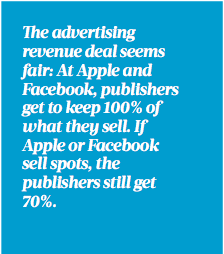
At the launch of Instant Articles, Facebook had strict ad limits that irked publishers, but in late 2015, they relented. Facebook allowed publishers to increase the number of ads in each article (from one for every 500 words to one for every 350 and to sell Facebook-only ad campaigns for the first time. Facebook also gave publishers the option to highlight and to use “related articles” at the bottom of Instant Articles to link to content on their own web- site, including — and this is a big deal — links to branded content and sponsored posts.
To maximise income from every story, Facebook also instituted a new system in late 2015 that automatically fills ad slots left unsold bypublishers. The system detects unsold positions and places ads on a page for every 350 words, ensuring maximum ad load for each Instant Article. Publishers were “leaving money on the table by under-serving ads,” Facebook’s Reckhow told The Wall Street Journal.
All of those changes apparently have worked. In February 2016, publishers reported Instant Articles now generate the same amount of ad revenue on a per-view basis as page views on their own mobile properties.
“A lot has changed,” Joe Speiser, co-founder of LittleThings.com, which publishes stories and videos optimised for social sharing, told The Wall Street Journal (WSJ). “The biggest stumbling block with Instant Articles was that we were making less there than with visits to our own site. We are now seeing parity with our mobile web version.”
“We’ve been pleasantly surprised to see the monetisation is so strong. It’s every bit as good as on our own site”, Business Insider president Julie Hansen told the WSJ. “We’re continuing to listen to publishers about what they want from Instant Articles, and we’re going to continue to do this,” Facebook’s Reckhow said.
“If you look at The New York Times in Instant Articles, they have not only ads, but they also have, in every article, a signup box for an email list, and they also have a box of related arti- cles from The New York Times,” Reckhow told The Nieman Lab. “You can see, in one Instant Article, the core elements of what a publisher like The New York Times is trying to do — it has both an ad and a subscription opportunity. We worked with them to make sure that these pieces work — the ads, the email signups, the related articles, and redistribution.”
At the end of 2015, Facebook claimed to have more than 350 publishers enrolled in Instant Articles with more than 100 posting daily.
Just two months earlier, there were only twenty publishers enrolled in the programme. The 350 publishers span a wide number of countries, not just the US. Both India and Ger- many have more than 25 participating publishers. And in late 2015, Facebook released Instant Articles across Asia — including Facebook’s second biggest market, India — and Latin America At the end of the day, it could come down to nothing more complicated than making the decision to go where the audience is.
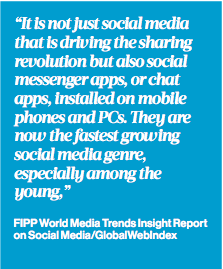
And that’s increasingly on social media. The average global user spends more than six hours online, of which almost two hours was spent on social networking, according to GlobalWebIndex, which reports that social networking is the No. 1 activity online in every country.
The most prolific social networking countries by percentage of time spent are Japan, the Netherlands, Germany, France, Ireland, Australia, Sweden, Poland, the United Kingdom, South Korea and Spain, according to the FIPP World Media Trends Insight Report on Social Media based on the GlobalWebIndex.
Brazil and Italy are among the most prolific content sharers via email or social networks, with 54% of Brazilians and 44% of Italians sharing content via social networks or email every week, according to the FIPP report. Other countries where users are also prolific sharers are Spain (40%), the United States (35%); Finland (24%), Denmark (23%), and France (21%).
In the UK, for example, social media passed entertainment in mid-2015 as the country’s favourite online activity. Of the two hours and 51 minutes a day people in the UK on average spend on the web, social media accounted for one-fifth of their time (entertainment activities such as watching TV shows, YouTube videos and listening to music dropped by nearly half from 22.1% to 12.4%) .
The social media impact changes a bit when looking at the highest penetration of social media in regions. The greatest social media penetrations are in North America (58%), South America (48%), Western Europe (47%, Eastern Europe (45%), Oceania (45%); and East Asia (45%).
“It is not just social media that is driving the sharing revolution but also social messenger apps, or chat apps, installed on mobile phones and PCs. They are now the fastest growing social media genre, especially among the young,” according to the FIPP Report. “By far the most popular is Facebook Messenger, followed by WeChat and WhatsApp among global users.”
Social media as a whole is a powerhouse of referrals, but Facebook is the gorilla. Zuckerberg’s 1.5 billion-member service passed Google as the leading referral of traffic to publishers in June 2015. And in July, Facebook extended its lead to three percentage points, 38.2% to 35.2%, according to content analytics firm parse.ly. The study looked at major publishers, including Telegraph Media Group, Condé Nast, The Atlantic, Reuters, The New Republic Advance Digital, Mashable, Business Insider and Vocativ and more.
That said, while Facebook may have passed Google in sending referrals to publishers, some publishers are actually seeing a decline in direct Facebook referrals. Analysts attribute that to the rise in native content, where readers are not sent to the publisher’s website to read content but consume it on Facebook, and possibly a change in Facebook’s algorithm for sending content to a reader’s NewsFeed that may be favouring native content over outbound links.
The rise of native content is contributing to the beginning of the end of the era of Face- book being the dominant referral source for publishers, Huffington Post CEO Jared Grusd told Digiday. “They [the publishers] themselves have started to dial down the referral knob.
“The way many companies and marketers look at traditional metrics is becoming some- what anachronistic because they measure one slice of the equation [referrals, not native consumption],” Grusd said. “The tools haven’t caught up to where the behaviour is. But even though there’s uncertainty, if we can deliver on our editorial pillars, the rest will take care of itself. We can possibly build an even bigger audience, and data sets will follow, and so will monetisation. Publishers won’t accept an eco- system where those things don’t exist and all the platforms know that.”
If social is the platform of the future, mo- bile is the vehicle. “The top social network, Facebook, reports that more than half of its traffic now comes from mobiles, not desktops,” according to the FIPP Report. “The mobile us- age trend is exploding across all categories of internet activities.”
Those smartphone users spend four-fifths of their time on just five apps (which differ by person), according to a Forrester survey. “If you’re not finding ways to be in those apps, it’s hard to get in front of people on their phones,” Dan Rose, Facebook VP of partnerships told a panel at the Paley International Council Summit in late 2015.
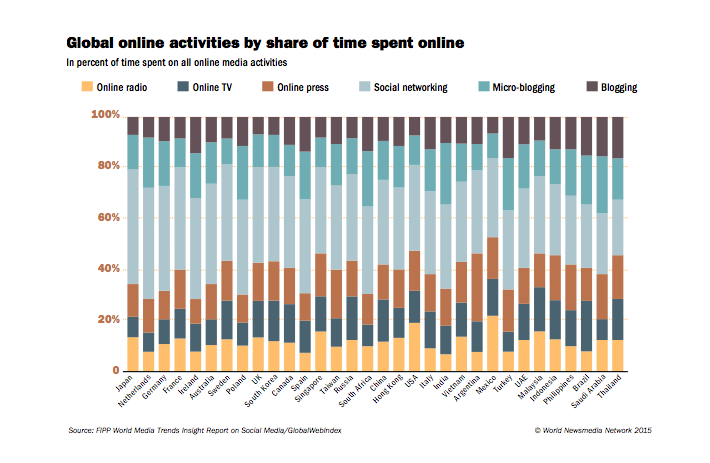
The Washington Post is one publisher embracing Instant Articles with both arms, putting all of its content on Instant Articles.
“The thing that we’ve really learned with Jeff Bezos is that experimentation at scale is really the way to do it,” The Washington Post’s Haik told the Paley Summit. “There’s not a risk. It’s not a one-way door. Why not be all the way in?… It’s better for users. The risk to us is just dipping our toes in. We don’t think we’d understand it as well.”
It would appear to be working, as the Post had 71.6 million digital unique users last November, surpassing its previous record of 66.9 million monthly users, according to comScore. The Post passed the New York Times for the second consecutive month and closed the gap with CNN and BuzzFeed. Time spent per visitor was nearly 15 minutes — an increase of 21.1% from last year, according to the paper. Millennials made up 44.8% of The Post’s total mobile audience and 40% of its total digital audience.
“So how we’re going to grow this side of the business and dramatically increase that number, as we’ve been doing, is really this distributed platforms piece of it, which is now an official initiative at The Washington Post,” Haik said. “All sides of the business work on that I work in the newsroom proper, but all around the company, with tech and product and design and research and business development, everyone is involved because all sides of the business have a stake in it some way.”
Over at The Atlantic, they are posting 60- 70% of their content on Instant Articles, leaving out only stories with coding that is not support- ed, according to Kimberly Lau, VP and general manager of Atlantic Digital.
It’s the same story at Slate, according to vice chairman Dan Check, who said they will soon post 100% of all their stories in Instant Articles. “We see this as being a really good way to grow the total size of our audience,” he told the Paley Summit.
“When you find a place where people are and when you give them something that they love in that place, it will grow over time into something that’s huge,” Check said. “Apple News will reach millions of people who are not yet reading Slate.”
Media watchers believe this is more than a temporary phenomenon. Jeff Jarvis, the director of the Tow-Knight Centre for Entrepreneurial Journalism in New York, sees the dawning of a new era in which content goes to the people instead of the people going to content.
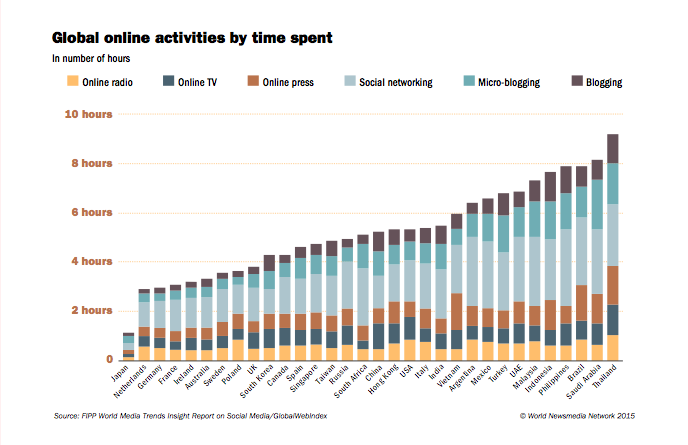
“Think of it this way: If The New York Times struck a deal with CVS (a US pharmacy chain) to have its print edition sold at CVS, you wouldn’t see a bunch of hand-wringing abouthow it’s handing over the Times’ keys to CVS,” content and social media marketing consultant Simon Owens told the Poynter Institute.
So perhaps publishers who missed “The Year of Distributed Content” (believe it or not, that was LAST year – 2015 – according to the Neiman Lab director Josh Benton) can still hop on the train, especially if the distributors can guar- antee just two key conditions: Control over ad revenue and data sharing.
To insist on those conditions, publishers are not exactly unarmed walking into negotiations with the platform operators.
All of the platform operators have come to recognise that their users want quality con- tent from respected sources — That’s us, folks! And only us! Magazine media have established brands and reputations; their content is known and trusted by consumers. That applies equal- ly to legacy AND new high-quality pure-play brands like Refinery29, Vox, Vice, etc.
The trading of the best content in a niche for audience and new revenue would seem to be a marriage made in new media heaven.
On the other hand…
Critics of giving the platforms exclusive, or “native”, content that lives only on a social media platform insist it amounts to giving away the store.
“Right now, your desktop content site can expect no click-throughs and no ad views. That sound? Tumbleweed blowing through your website,” wrote Andrew Pemberton, director of the US-based 360 digital product development group Furthr, for Marketing Magazine. “If that sounds bad, it’s because it is. Even Google is hurting over this.”
Advertising presents another challenge. Google’s Accelerated Mobile Pages (AMP), for example, does not accommodate all ad formats, handicapping publishers’ ability to maximise revenue. Basically, if an ad contains elements that slow its load time, Google won’t accept it. And the more complex ads tend to draw the highest CPMs.
While publishers get to keep 100% of the revenue from ads they sell on Instant Articles, Facebook can change the rules on a whim. Additionally, Facebook is not allowing publishers to sell ads on native video. A test of video ads with six publishers last summer has not resulted in a system for publishers to sell lucrative video ads.
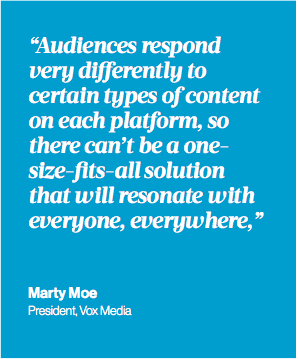
Google’s AMP also limits other publisher revenue-raising tricks such as Outbrain, which uses behavioural targeting to recommend branded content which advertisers pay publishers to run. AMP also won’t accept header bidding, which publishers use to offer advertisers simultaneous competitive programmatic bidding on stories. Header bidding is reported to increase yields by 10% but at the same time it slows loading time due to the coding in the ad. “I’ve heard publishers say, ‘We get it, we need to have a great experience,’ but there are concerns about monetisation,” one ad tech company source that supports AMP told Digiday. What might be a “disruptive” ad to user-experience experts could also be an “impactful” ad to a brand — and lucrative to a publisher, he said.
Magazine media also worry about how much extra work is required to create ads exclusively for the Google AMP format, a concern publishers have about all the platforms.
But Google believes publishers can have their cake and eat it, too. Google is working with publishers, ad tech companies, advertisers, and buyers to constantly develop technology to improve mobile ads. “This group has only scratched the surface but we’re excited to see where this will go,” a Google spokesperson told Digiday. “We think there are huge opportunities to create strong revenue streams for publishers while delivering a great mobile experience for users.”
Creating native content for each social platform is also not easy or cheap. Each platform is different — different types of audiences, different environments, different strengths and weaknesses.
“Say we have a piece of content and we put it on our site, on Vine, [and] on Snapchat. Each time we put it somewhere new, we have to format and cut it a little differently and think about how that content fits on each platform. And all of that takes time,” Dorth Raphaely, general manager of US sports site Bleacher Report, told Digiday.
“The biggest challenge, and opportunity, in publishing to platforms is optimising content types and formats for each platform,” Vox Media president Marty Moe told Digiday. “Different platforms require different approaches, whether that is a small tweak to a format or an entirely different way of telling a story, and it requires focus, measurement, iteration and learning over time.

“Audiences respond very differently to certain types of content on each platform, so there can’t be a one-size-fits-all solution that will resonate with everyone, everywhere,” he said. “For example, we have a team focused specifically on programming for Snapchat, understanding that specific audience, and creating content that performs well on that platform. We will do this for all the major platforms.”
Finally, there is the problem of data. Apple doesn’t collect or sell reader data. As a matter of fact, they consider it a major differentiator which they hope will attract more Apple users as protecting privacy becomes more and more important to consumers. Apple makes a point of having its devices know as much as possible about a user to optimise the user experience, but the company doesn’t want to know what its own devices know.
“We don’t want to know — All of this is ‘on device’, and it stays on device under your control,” Apple software engineering VP Craig Federighi told the company’s Worldwide Developers Conference in June 2015 to wild applause. The iOS and even Apple News is “designed from the ground up with your privacy in mind,” he said.
That’s great for the consumer, but it is not so great for publishers looking to sell advertising against consumer behaviours and interests.
Facebook is the best of the bunch in terms of data, but still doesn’t deliver everything magazine media need and want. “Right now, Facebook is giving us [data] article-by-article. It’s not aggregated in any way. So on the individual Instant Articles, they’re giving us information on page views and scroll depth,” Atlantic Digital’s Kimberly Lau told the Paley Summit. “Beyond that, we have tagging from Omniture and comScore, and so we know, in our own analytics, how many page views we’re getting.
“Data can be an issue — Facebook gives us a significant level of data, but something like Instagram doesn’t really have any real viable data for publishers outside of the standard engagement metrics,” Steven Belser, senior vice president of US-based distributed media company NowThis, told Digiday. “The same thing goes for publishers who are distributing content through Snapchat via the ‘Stories’ feature, which doesn’t have the same data or analytics as a publisher that is distributing directly through Discover. I can see how it can be daunting to not have that level of transparency.
“Nonetheless, if you’re serious about the distributed model, there’s still a lot of data to form valid conclusions about your audience. It might not be as robust as some pub[lication]s would like, but it’s there,” Belser said. “We see this as being a really good way to grow the total size of our audience.”
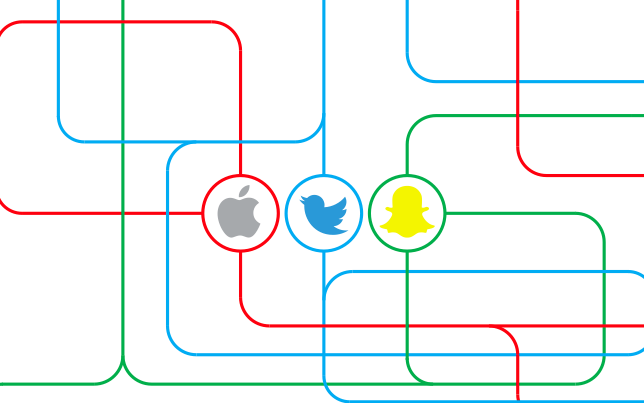
So, what to do?
Not jumping into the game is to risk losing access to valuable new audiences and new sources of revenue, as well as falling off readers’ and potential readers’ radar screens.
“We’ve seen that there are great returns on getting in early on these sorts of things,” Slate’s Dan Check told the Paley Summit.
“I have one bit of advice: Don’t do it without the data, people. It’s a damned fine idea to go to the readers rather than make them come to you — BuzzFeed does it; so does Vox; so does Reported.ly. It’s wonderful to get more audience and branding on Facebook. It’d be super peachy to get a share of revenue from Facebook at last. All that is great,” said Jeff Jarvis, media analyst and blogger on buzzmachine.com: “But keep in mind where the real value is: in the relation- ship, in knowing what people — individuals and communities, not a faceless, anonymous mass — need and want and know so you can give them relevance and value and so they will give you greater usage, engagement, attention, loyalty and advertising value in return.”
“Best case? These arrangements buy time until more organisations with journalistic heft get their business-model house in order and can exert greater leverage in deals with the traffic brokers,” wrote Rick Edmonds, media business analyst for the media think tank Poynter Institute. “But not yet. Probably not in 2016.”

This article is one of many chapters published in our book, Innovations in Magazine Media 2016 World Report.


